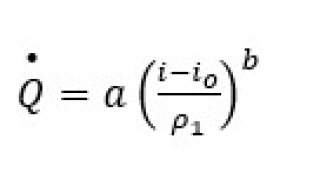
The ISO method for orifice design and calibration is grounded in the ideal square-root relation between pressure drop and flow rate, specifies the in-pipe structure for an orifice, and corrects the nonideal relation with empirical relations. Unfortunately, for the empirical correction, the complexity of the 28-coefficient Reader-Harris/Gallagher equation and the 8-coefficient expansibility relation all add potential for implementation error. Further, in many applications the structure of the device or piping cannot meet ideal specifications.
Of course, for official and legal situations you should use the methods for orifice calibration as indicated by standards. However, engineering practice desires to minimize complexity. Accordingly, for internal use, you might find that relaxing the square-root basis provides a power-law relation that is much simpler, and just as accurate. Further, it does not require the piping structure that seeks to create a near ideal up- and down-stream conditions, easing installation design constraints. However, it does require application-specific calibration.

